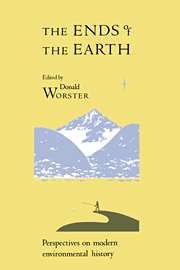Book contents
- Frontmatter
- Contents
- Preface
- INTRODUCTION
- DYNAMICS OF CHANGE
- THE EUROPEAN INVASION
- CONSERVING NATURE – PAST AND PRESENT
- 8 The Myth of the Southern Soil Miner: Macrohistory, Agricultural Innovation, and Environmental Change
- 9 Toward an Interactive Theory of Nature and Culture: Ecology, Production, and Cognition in the California Fishing Industry
- 10 Efficiency, Equity, Esthetics: Shifting Themes in American Conservation
- 11 The Changing Face of Soviet Conservation
- CONCLUSION
- Appendix: Doing Environmental History
- Bibliography
- Contributors
- Index
11 - The Changing Face of Soviet Conservation
Published online by Cambridge University Press: 05 June 2012
- Frontmatter
- Contents
- Preface
- INTRODUCTION
- DYNAMICS OF CHANGE
- THE EUROPEAN INVASION
- CONSERVING NATURE – PAST AND PRESENT
- 8 The Myth of the Southern Soil Miner: Macrohistory, Agricultural Innovation, and Environmental Change
- 9 Toward an Interactive Theory of Nature and Culture: Ecology, Production, and Cognition in the California Fishing Industry
- 10 Efficiency, Equity, Esthetics: Shifting Themes in American Conservation
- 11 The Changing Face of Soviet Conservation
- CONCLUSION
- Appendix: Doing Environmental History
- Bibliography
- Contributors
- Index
Summary
To readers familiar with the history of American conservationism, the fate of the Russian and Soviet movement offers both striking parallels as well as some notable divergences. Who could fail to appreciate, for example, the similar upwellings of national indignation among Soviets and Americans during the 1960s when such national treasures as Lake Baikal and the Grand Canyon became the objects of development schemes? Indeed, the decades-long struggle between Soviet preservationists and logging, agricultural, and other economic interests echoes our own continuing war between the children of John Muir and those of Gifford Pinchot. Recent Soviet interest in outdoor recreation and national parks has also been a feature of modern American life, especially among our urban-educated population.
Yet, the differences in our two national experiences stand out just as dramatically. Where the American conservation movement's attention early became firmly focused on the protection of recreational amenities, preeminently national parks and game resources, the efforts of its Soviet counterpart were long directed at advancing a program for the ecological study of nature in order to guide economic development scientifically. Correspondingly, the Soviet conservation movement for most of its existence has been dominated to a far greater extent than the American by professional scientists, and its fate has been more closely linked to that of ecology as a science. The reasons for these significant differences lie in the realms of politics, culture, and social structure, and will be explored in this essay.
- Type
- Chapter
- Information
- The Ends of the EarthPerspectives on Modern Environmental History, pp. 252 - 274Publisher: Cambridge University PressPrint publication year: 1989

